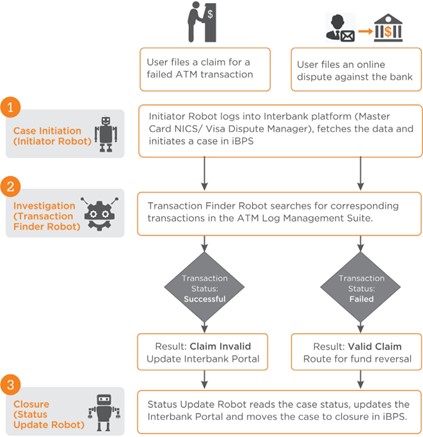When Robotic Process Automation (RPA) works in collaboration with BPM, the duo can do wonders for an organization. Regardless of your industry type, you’ll be able to achieve higher efficiency, lower costs, higher employee engagement and better overall customer experience. Let’s understand how you can leverage this promising technology to create business value and bring the next level of speed, transparency into your operations:
Insurance: Streamlining Claims Processing with RPA
The administrative side of claims processing involves humongous paperwork, exchange of files and data and a host of other activities. And, since accuracy and processing speed play a key role in claims management, RPA solution and Business Process Management (BPM) in tandem help insurers reduce processing time and enhance overall productivity.
In a typical claims processing case, agents spend a lot of time and effort in manually validating customers’ information. By leveraging bots to validate this information, you can easily approve or reject claims and ensure hassle-free claims processing.
With optimum work distribution, bots eliminate the scope of human errors, while reducing overall costs. They auto-scan and read incoming claims documents and extract the most relevant data in conjunction with the defined keywords. Further, they read personal information of an insured and extract insured name, invoice number and required data to process a claim. The extracted data is then automatically uploaded in the claims database for approval or rejection, with minimal manual intervention. The complete information is organized and checked against policy database in real-time.
Shared Services: Deriving Tangible Value in Accounts Payable
The basic objective of a Shared Services Center (SSC) is to achieve a higher level of service quality at a lower cost. However, with high manual intervention at every stage, lack of efficient monitoring & tracking mechanism, and opaque workflows, the end outcome is delayed decision-making and higher operational costs. To combat these challenges, Robotic Process Automation (RPA) along with Business Process Management (BPM) solutions can prove to be instrumental in achieving higher efficiency in Accounts Payable (AP). With bots, you can operate 24*7 and achieve better throughput. And, at the same time, Business Process Management (BPM) capabilities allow you to manage exceptions and drive process improvement. The duo holds the capability to redefine the AP process by orchestrating processes and eliminating errors.
Procure to Pay (AP)
You can streamline the intake of vendor invoices with BPM software, and auto-assign invoices to workers based on pre-defined rules. By leveraging bots across the process, you can minimize manual handoffs and check for vendor invoices & payments. Further, with BPM’s case management capabilities you can manage vendor/supplier inquiries and disputes.
Order to Invoice (AR)
You can analyze and establish sales quotes, and validate sales orders with bots. Using BPM’s Business Activity Monitor, you can monitor customer credit. You can easily create, distribute and track customer invoices, and process customer payments.
Record to Report (GL)
You can eliminate manual work and emulate human actions to record journal entries. Leveraging bots, you can reconcile accounts, collaborate and manage intercompany transactions, and keep track of detailed accounting master data for audit and regulatory purposes.
Transforming Employee Onboarding in Human Resources
In a typical process of strategically bringing new hires into an organization, HR representatives initiate the onboarding process. They fill in details of new hires, verify the provided details, and update information in multiple information systems. Since this routine paperwork of gathering, uploading and verifying new hires’ information is time-consuming and repetitive in nature, results in unnecessary delays.
With bots behind the scenes, they validate new hires’ information and exchange emails with the involved teams to initiate the required processes. Bots read emails, extract the required information, and store it in the database. In case of missing information, bots automatically send an email to the respective candidates, asking them to fill in the required information. Bots then validate the provided information, scan through the third-party database and intimate dependent teams to take appropriate actions for smooth onboarding of new hires.
Banking: Maximizing Process Efficiency in Dispute Management Resolution
With the involvement of multiple parties and complexity of the Dispute Management process, it’s not easy to provide timely, relevant and accurate resolutions to customers’ disputes. With manual intervention at every stage and lack of communication between departments, errors are introduced into the process. Various reasons trigger a dispute, such as fraud, non-receipt of services, errors in processing, and others.
However, with bots in place, you can maximize the process efficiency and bring down implementation costs by a significant margin. For instance – Robots log into interbank platforms, fetches the data and initiate a case in BPM software. They validate transactions and investigate disputes. Further, based on pre-defined rules and cognitive skills of bots, if a dispute stands valid, bots initiate a refund, update status in the interbank platform against the corresponding dispute and move the case to closure.

An illustration depicting how a dispute management, built on a BPM platform, resolves a dispute by leveraging RPA
Driving Efficiency in Residential Mortgage Loan Initiation
Business users manually process a loan application in the loan origination system and validate customers’ information. This paper-intensive process paves way for a series of business challenges, such as heavy data input, duplicity while keying data, and processing interruptions at the processing level, resulting in excessive time-consumption.
With bots in place, they initiate a loan by keying customers’ data against appropriate fields. They automatically fetch and accumulate required information and initiate third-party orders. Bots scan images, split & upload customer data in the required format, and raise exceptions wherever necessary. For each case, bots save a significant amount of time and drive efficiency in the overall process.
To conclude
The opportunity with Robotic Process Automation (RPA) is real and holds tremendous promise across all industries. Beyond cost savings, it instills a culture of better service delivery. It also ensures greater throughput, higher control and flexibility, and happier knowledge workers. And, all of this eventually leads to happier customers. Therefore, leverage RPA solution to bring the next level of speed, transparency into your operations and reap the maximum advantages of this new-age technology.
You might be interested in



25 Sep, 2025
Transforming Enterprises with Newgen’s Business Process Management Software

